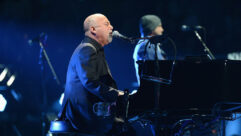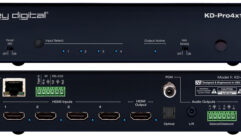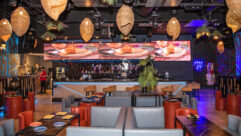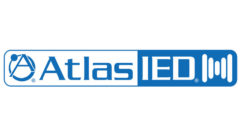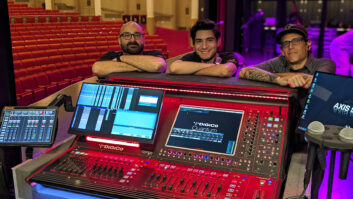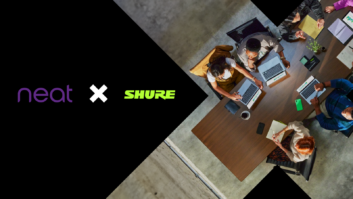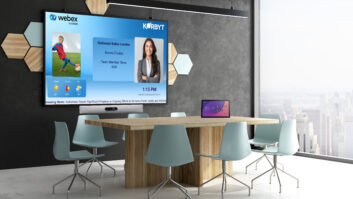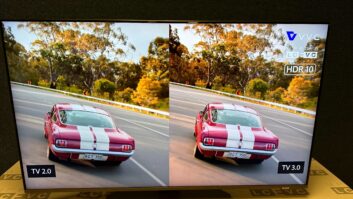Audio for High-energy Restaurant, Part 2
Mar 20, 2014 11:06 AM,
With Bennett Liles
With Bennett LilesListen to the Podcasts

Editor’s note: For your convenience, this transcription of the podcast includes timestamps. If you are listening to the podcast and reading its accompanying transcription, you can use the timestamps to jump to any part of the audio podcast by simply dragging the slider on the podcast to the time indicated in the transcription.
When baseball fans get together, the sound level can start shaking the place. At the Game Seven Grill in Phoenix, the Arizona Diamondbacks had to have a sound system that could compete with that intensity level both inside the bar and outside in the plaza. Mark Schultz from Parsons Technologies came up with the solution. That’s coming up next on the SVC Podcast.
SVC: Mark thanks for being back for part two on the SVC Podcast from the Phoenix office of Parsons Technologies. A complete renovation of the Game Seven Grille opened things up for a new sound system. In part one we talked about the inside but they have a huge plaza outside the place where the sound system has to not only cut through the noise, it’s got to be weather proof as well. You used Community R.25 95Ts I believe for that?
Yes we did. The outside is a separate zone so they can actually put different programming outside than what’s inside if they wanted to. Typically during a game, if people are sitting out there, they’ll put the radio broadcast on so they can hear what’s going on in the game. And then they use the R.25 94T’s because we had just finished using them inside on the concourse at the baseball stadium and the Diamondbacks liked them so well that they suggested we use them in the plaza as well. So that’s what we put in out there and it works great. [Timestamp: 1:46]
You’ve got all of this centrally controlled from inside. Is the wiring run through underground conduit or did you have to go wireless with some of it?
Since the inside seating is all open what we were able to do is just drill through the brick wall and put conduit sleeves in and just run it right out through the wall right to where the speaker locations were. So we didn’t have to go through any underground conduits or anything; it was all pretty straightforward as far as getting it out there. And then everything just goes back to the central amplifier rack which controls both inside and outside. [Timestamp: 2:18]
OK, you’ve got a place that’s secure and I think you said before that you’ve got two control points.
Yeah. One is in the manager’s office and one is at the equipment rack itself, in the little closet inside the restaurant and they can control from there both the volume and program selection for the inside zone and then separately also for the outside zone. [Timestamp: 2:39]
I guess the input selection wouldn’t be tricky at all but if you’re controlling a sound system from an acoustically separate area where you can’t hear the output that could be a little strange unless you have some kind of preset arranged for it.
Yeah, well one of the nice things about the controller is it does give them a readout that tells them what the signal – the level is. And we’ve got a meter built so they actually visually see what’s going on. And over the course of the first season they got pretty familiar with what level it had to be at for a particular sized crowd and what noise levels and whatnot, so they’ve gotten pretty good at setting the levels so it’s right on target. [Timestamp: 3:17]
Audio for High-energy Restaurant, Part 2
Mar 20, 2014 11:06 AM,
With Bennett Liles
We’ve talked about the sound system but they’ve got a pretty big video system in there with monitors everywhere. What kind of video sources do they have? I guess they would have plenty of broadcast channels at least.
What they’ve got is actually it’s TVs. They’re all around inside the facility. And the TV distribution system for the stadium actually, off of that they send a feed over to the restaurant and they’ve got all the same channels that they have next door at the stadium at the restaurant. So they can pick up – primarily they’re sports channels. You’re going to get your ESPN, your local broadcast games here in Phoenix, and then a number of other different channels; CNN, etc. And they can go around and pick whatever channel they want on any TV and set it up however they want it. Usually when a game is on, I think every TV’s got the baseball game on it. [Timestamp: 4:10]
Yeah, I guess they just take the local broadcast on that.
Correct.
And do they have the same control points for the video system as they do for sound?
Actually they kind of went a little, I guess you’d say low level, as far as controls. So they just got a remote. This guy runs around and sets the channels because for the most part they aren’t changing channels all that often. Usually they’ll set that up before they open up the restaurant and then let it go unless somebody specifically wants something changed. [Timestamp: 4:40]
I guess it’s important on those things not to get it overly complicated because you never know who’s going to have to run it.
Yeah.
And I guess the fans will give you some negative feedback real quick when you don’t have the right source in there.
Yeah, the only thing that we ended up doing – and we found this out after the first game – we had a radio in there so they could get the radio broadcast, but since they have the TV broadcast on the TVs, the two of them weren’t necessarily in sync. So we ended up adding an actual TV tuner to the system as a source select they can pick so they can get the actual audio off of the TV onto the speakers and it matches with what they’re showing up front on all the displays. [Timestamp: 5:18]
When you got all the wiring run and everything connected, how did the system testing go? Any surprises or did it operate pretty much as you planned?
It was pretty much the way we thought it was going it go. It took a couple of hours of just running around and setting the levels and making sure we had things balanced accordingly and then just a minor little bit of equalization and things of that sort. But for the most part it went pretty smoothly. [Timestamp: 5:44]
And from the customers, they’ll let you know it if they don’t like it so all’s been pretty quiet at least as far as any complaints.
Yeah, everybody seems to love it. I mean the place seems to always be packed, so they don’t have any problem with that at all.
Are there further renovations planned for the Game Seven Grill? Is there like a phase two to this thing?
Yeah. They’ve contacted us, the Diamondbacks have already, and it looks like before this next season the hope is there’s a second floor they’re going to want to have us do some work in upstairs. That’s going to be primarily though private dining rooms and meeting rooms and things of that sort that they’ll be able to lease out for private parties and things of that sort. But it’ll be much the same idea and they’ll have the same basic sources, maybe a few microphones up there they’ll be able to use for some of these special events that they have up there. So that’s in the works as we speak. [Timestamp: 6:36]
Well, hopefully the fortunes of the team coincide with the way things are going at the Game Seven Grill. In the meantime, what’s coming up for Parsons Technologies?
Well the one we’re just finishing up down here in Phoenix is we just are finishing up the new spring training facility for the Chicago Cubs out in Mesa. Their first game is February 27. And then as far as company wide, I know right now out of our Minneapolis office they’re working on a renovation or an upgrade out at the stadium for the Carolina Panthers. So those are the two big ones, and I guess the other thing that we’re waiting to see about is the Minnesota Vikings stadium, what’s going to happen up there. [Timestamp: 7:20]
With baseball season coming up on us, I know the deadlines are going to be on you before you know it. But as for the Minnesota Vikings, I guess it’s going to be a while before they get into action again so you should have at least a little breathing space on that one.
Yeah. That’s going to be down the road a little ways.
OK, Mark. Mark Schultz from Parsons Technologies in Phoenix and the Arizona Diamondbacks’ Game Seven Grill. And your headquarters is actually in Minneapolis.
Correct. Thanks for telling us the story on it Mark and maybe we’ll catch up with you after you’ve got that Vikings project done.
Okay.


